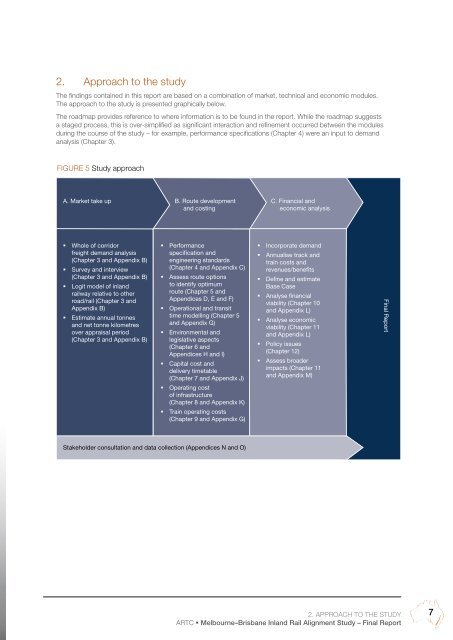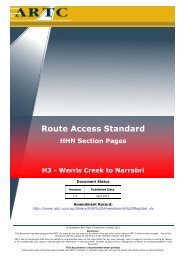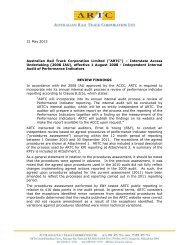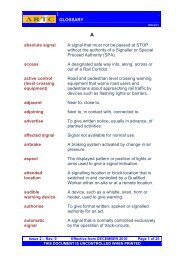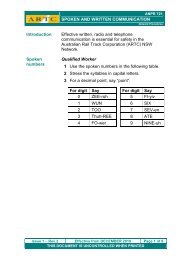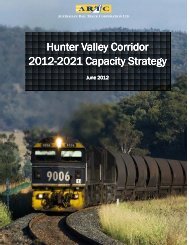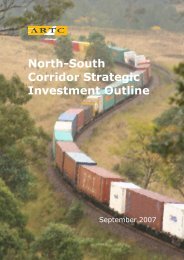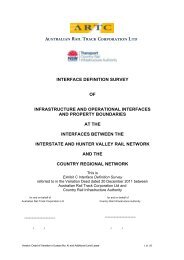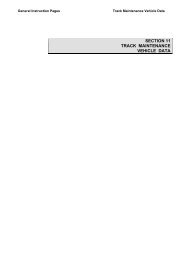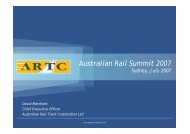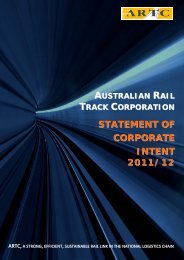MelbourneâBrisbane Inland Rail Alignment Study - Australian Rail ...
MelbourneâBrisbane Inland Rail Alignment Study - Australian Rail ...
MelbourneâBrisbane Inland Rail Alignment Study - Australian Rail ...
You also want an ePaper? Increase the reach of your titles
YUMPU automatically turns print PDFs into web optimized ePapers that Google loves.
2. Approach to the study<br />
The findings contained in this report are based on a combination of market, technical and economic modules.<br />
The approach to the study is presented graphically below.<br />
The roadmap provides reference to where information is to be found in the report. While the roadmap suggests<br />
a staged process, this is over-simplified as significant interaction and refinement occurred between the modules<br />
during the course of the study – for example, performance specifications (Chapter 4) were an input to demand<br />
analysis (Chapter 3).<br />
Figure 5 <strong>Study</strong> approach<br />
A. Market take up<br />
B. Route development<br />
and costing<br />
C. Financial and<br />
economic analysis<br />
<br />
<br />
<br />
<br />
Whole of corridor<br />
freight demand analysis<br />
(Chapter 3 and Appendix B)<br />
Survey and interview<br />
(Chapter 3 and Appendix B)<br />
Logit model of inland<br />
railway relative to other<br />
road/rail (Chapter 3 and<br />
Appendix B)<br />
Estimate annual tonnes<br />
and net tonne kilometres<br />
over appraisal period<br />
(Chapter 3 and Appendix B)<br />
<br />
<br />
<br />
<br />
<br />
<br />
<br />
Performance<br />
specification and<br />
engineering standards<br />
(Chapter 4 and Appendix C)<br />
Assess route options<br />
to identify optimum<br />
route (Chapter 5 and<br />
Appendices D, E and F)<br />
Operational and transit<br />
time modelling (Chapter 5<br />
and Appendix G)<br />
Environmental and<br />
legislative aspects<br />
(Chapter 6 and<br />
Appendices H and I)<br />
Capital cost and<br />
delivery timetable<br />
(Chapter 7 and Appendix J)<br />
Operating cost<br />
of infrastructure<br />
(Chapter 8 and Appendix K)<br />
Train operating costs<br />
(Chapter 9 and Appendix G)<br />
<br />
<br />
<br />
<br />
<br />
<br />
<br />
Incorporate demand<br />
Annualise track and<br />
train costs and<br />
revenues/benefits<br />
Define and estimate<br />
Base Case<br />
Analyse financial<br />
viability (Chapter 10<br />
and Appendix L)<br />
Analyse economic<br />
viability (Chapter 11<br />
and Appendix L)<br />
Policy issues<br />
(Chapter 12)<br />
Assess broader<br />
impacts (Chapter 11<br />
and Appendix M)<br />
Final Report<br />
Stakeholder consultation and data collection (Appendices N and O)<br />
2. APPROACH TO THE STUDY<br />
ARTC • Melbourne–Brisbane <strong>Inland</strong> <strong>Rail</strong> <strong>Alignment</strong> <strong>Study</strong> – Final Report<br />
7


